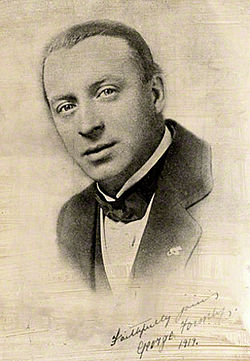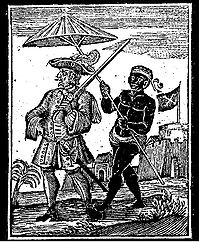Portal:Biography
The Biography Portal
A biography, or simply bio, is a detailed description of a person's life. It involves more than just basic facts like education, work, relationships, and death; it portrays a person's experience of these life events. Unlike a profile or curriculum vitae (résumé), a biography presents a subject's life story, highlighting various aspects of their life, including intimate details of experience, and may include an analysis of the subject's personality.
Biographical works are usually non-fiction, but fiction can also be used to portray a person's life. One in-depth form of biographical coverage is called legacy writing. Works in diverse media, from literature to film, form the genre known as biography.
An authorized biography is written with the permission, cooperation, and at times, participation of a subject or a subject's heirs. An autobiography is written by the person themselves, sometimes with the assistance of a collaborator or ghostwriter. (Full article...)
Featured biographies –
Born at the family house Benwell Dene in Newcastle upon Tyne, Hodgkin was a son of the banker and historian Thomas Hodgkin, and was part of a so-called "Quaker dynasty" with many accomplished relatives. From 1896 to 1899, he attended Balliol College, Oxford, graduating with first-class honours in the Final School of Modern History. The following year, he volunteered to serve in the Northumberland Fusiliers, rejoining them during the First World War, which ultimately led to him being forced to leave the Society of Friends. (Full article...)
Le Mesurier became interested in the stage as a young adult and enrolled at the Fay Compton Studio of Dramatic Art in 1933. From there he took a position in repertory theatre and made his stage debut in September 1934 at the Palladium Theatre in Edinburgh in the J. B. Priestley play Dangerous Corner. He later accepted an offer to work with Alec Guinness in a John Gielgud production of Hamlet. He first appeared on television in 1938 as Seigneur de Miolans in the BBC broadcast of The Marvellous History of St Bernard. During the Second World War Le Mesurier was posted to British India, as a captain with the Royal Tank Regiment. Following the war, he returned to acting and made his film debut in 1948, starring in the second feature comedy short Death in the Hand, opposite Esme Percy and Ernest Jay. (Full article...)
Joseph Francis Shea (September 5, 1925 – February 14, 1999) was an American aerospace engineer and NASA manager. Born in the New York City borough of the Bronx, he was educated at the University of Michigan, receiving a Ph.D. in Engineering Mechanics in 1955. After working for Bell Labs on the radio inertial guidance system of the Titan I intercontinental ballistic missile, he was hired by NASA in 1961. As Deputy Director of NASA's Office of Manned Space Flight, and later as head of the Apollo Spacecraft Program Office, Shea played a key role in shaping the course of the Apollo program, helping to lead NASA to the decision in favor of lunar orbit rendezvous and supporting "all up" testing of the Saturn V rocket. While sometimes causing controversy within the agency, Shea was remembered by his former colleague George Mueller as "one of the greatest systems engineers of our time".
Deeply involved in the investigation of the 1967 Apollo 1 fire, Shea suffered from stress. He was moved to an alternative position in Washington and left NASA shortly afterwards. From 1968 until 1990 he worked as a senior manager at Raytheon in Lexington, Massachusetts, and thereafter became an adjunct professor of aeronautics and astronautics at MIT. While Shea served as a consultant for NASA on the redesign of the International Space Station in 1993, he was forced to resign from the position due to health issues. (Full article...)
Adam Craig Gilchrist AM (/ˈɡɪlkrɪst/; born 14 November 1971) is an Australian cricket commentator and former international cricketer and captain of the Australia national cricket team. He was an attacking left-handed batsman and record-breaking wicket-keeper, who redefined the role for the Australia national team through his aggressive batting. Widely regarded as the greatest wicket-keeper-batsman in the history of the game, Gilchrist held the world record for the most dismissals by a wicket-keeper in One Day International (ODI) cricket until it was surpassed by Kumar Sangakkara in 2015 and the most by an Australian in Test cricket. Gilchrist was a member of the Australian team that won three consecutive world titles in a row: the 1999 Cricket World Cup, the 2003 Cricket World Cup, and the 2007 Cricket World Cup, along with winning the 2006 ICC Champions Trophy.
His strike rate is amongst the highest in the history of both ODI and Test cricket; his 57 ball century against England at Perth in December 2006 is the fourth-fastest century in all Test cricket. He was the first player to have hit 100 sixes in Test cricket. His 17 Test centuries and 16 in ODIs are both second only to Sangakkara by a wicket-keeper. He holds the unique record of scoring at least 50 runs in successive World Cup finals (in 1999, 2003 and 2007). His 149 off 101 balls against Sri Lanka in the 2007 World Cup final is rated one of the greatest World Cup innings of all time. He is one of only three players to have won three World Cup titles. (Full article...)

George Formby (born James Lawler Booth; 4 October 1875 – 8 February 1921) was an English comedian and singer in musical theatre, known as one of the greatest music hall performers of the early 20th century. His comedy played upon Lancashire stereotypes, and he was popular around Britain. His nickname, "The Wigan Nightingale", was coined because of the way he would use his bronchial cough as a comedic device in his act.
Formby was born into poverty in the industrial North West England; his mother was an alcoholic and part-time prostitute, and during much of his youth he was maltreated. To earn money he would sing for pennies on street corners, before he joined a singing duo in his teens. He began to develop his own act during the 1890s and built up a following in Lancashire. He also developed a series of stage characters, including that of "John Willie", which is described by the cultural historian Jeffrey Richards as "the archetypal gormless Lancashire lad ... hen-pecked, accident-prone, but muddling through." Formby also had a successful recording career and made the transition from music hall to revue in 1916. (Full article...)
Olivier Eugène Prosper Charles Messiaen (UK: /ˈmɛsiæ̃/, US: /mɛˈsjæ̃, meɪˈsjæ̃, mɛˈsjɒ̃/; French: [ɔlivje øʒɛn pʁɔspɛʁ ʃaʁl mɛsjɑ̃]; 10 December 1908 – 27 April 1992) was a French composer, organist, and ornithologist. One of the major composers of the 20th century, he was also an outstanding teacher of composition and musical analysis.
Messiaen entered the Paris Conservatoire at age 11 and studied with Paul Dukas, Maurice Emmanuel, Charles-Marie Widor and Marcel Dupré, among others. He was appointed organist at the Église de la Sainte-Trinité, Paris, in 1931, a post he held for 61 years, until his death. He taught at the Schola Cantorum de Paris during the 1930s. After the fall of France in 1940, Messiaen was interned for nine months in the German prisoner of war camp Stalag VIII-A, where he composed his Quatuor pour la fin du temps (Quartet for the End of Time) for the four instruments available in the prison—piano, violin, cello and clarinet. The piece was first performed by Messiaen and fellow prisoners for an audience of inmates and prison guards. Soon after his release in 1941, Messiaen was appointed professor of harmony at the Paris Conservatoire. In 1966, he was appointed professor of composition there, and he held both positions until retiring in 1978. His many distinguished pupils included Iannis Xenakis, George Benjamin, Alexander Goehr, Pierre Boulez, Jacques Hétu, Tristan Murail, Karlheinz Stockhausen, György Kurtág, and Yvonne Loriod, who became his second wife. (Full article...)
Carolynn Marie Hill (born January 3, 1961) is an American rock climber. Widely regarded as one of the leading competition climbers, traditional climbers (and particularly big wall climbers), sport climbers, and boulderers in the world during the late 1980s and early 1990s, she is famous for making the first free ascent of the difficult sheer rock face of The Nose on El Capitan in Yosemite Valley, and for repeating it the next year in less than 24 hours. She has been described as both one of the best female climbers in the world and one of the best climbers in the history of the sport. Hill was the first-ever female in history to redpoint a 5.12d (7c), 5.13a (7c+) and 5.14a (8b+) graded sport climbing route. Hill shaped rock climbing for women and became a public spokesperson, helping it gain wider popularity and arguing for sex equality. Hill has publicized climbing by appearing on television shows and documentaries and writing an autobiography, Climbing Free: My Life in the Vertical World.
Hill was a gymnast early in life, nearly broke a world record lifting weights, and ran competitively. She took to climbing at a young age, showing a natural aptitude for the activity, and became a part of the climbing community in Southern California and Camp 4 in Yosemite Valley. She traveled around the United States during the early 1980s climbing increasingly difficult routes and setting records for first female ascents and for first ascents. From 1986 to 1992 Hill was one of the world's most accomplished competition climbers, winning over thirty international titles, including five victories at the Arco Rock Master. This coincided with the era when the leading female climbers caught up with the leading men. In 1992, Hill left competitive climbing and returned to traditional climbing. She set for herself the challenge of free climbing The Nose of El Capitan, her greatest climbing feat. Hill continues to climb and has not stopped taking on ambitious climbs. As of 2013, she was a sponsored athlete for the Patagonia gear and clothing company and owned a small business that offered climbing courses. (Full article...)
Virginia Eliza Poe (née Clemm; August 15, 1822 – January 30, 1847) was the wife of American writer Edgar Allan Poe. The couple were first cousins and publicly married when Virginia Clemm was 13 and Poe was 27. Biographers disagree as to the nature of the couple's relationship. Though their marriage was loving, some biographers suggest they viewed one another more like a brother and sister. In January 1842, she contracted tuberculosis, growing worse for five years until she died of the disease at the age of 24 in the family's cottage, at that time outside New York City.
Along with other family members, Virginia Clemm and Edgar Allan Poe lived together off and on for several years before their marriage. The couple often moved to accommodate Poe's employment, living intermittently in Baltimore, Philadelphia, and New York. A few years after their wedding, Poe was involved in a substantial scandal involving Frances Sargent Osgood and Elizabeth F. Ellet. Rumors about amorous improprieties on her husband's part affected Virginia Poe so much that on her deathbed she claimed that Ellet had murdered her. After her death, her body was eventually placed under the same memorial marker as her husband's in Westminster Hall and Burying Ground in Baltimore, Maryland. Only one image of Virginia Eliza Clemm Poe has been authenticated: a watercolor portrait painted several hours after her death. (Full article...)
Fatima Whitbread, MBE (née Vedad; born 3 March 1961) is a British retired javelin thrower. She broke the world record with a throw of 77.44 m (254 ft 3⁄4 in) in the qualifying round of the 1986 European Athletics Championships in Stuttgart, and became the first British athlete to set a world record in a throwing event. Whitbread went on to win the European title that year, and took the gold medal at the 1987 World Championships. She is also a two-time Olympic medallist, winning bronze at the 1984 Summer Olympics and silver at the 1988 Summer Olympics. She won the same medals, respectively, in the Commonwealth Games of 1982 and 1986.
After a difficult early childhood, Fatima Vedad was adopted by the family of Margaret Whitbread, a javelin coach. Whitbread won the 1977 English Schools' Athletics Championships intermediate title, and was selected for the 1978 Commonwealth Games, where she finished sixth. The following year, she took gold at the 1979 European Athletics Junior Championships. During her career, she had a well-publicised rivalry with another British javelin athlete, Tessa Sanderson. Whitbread's later career was affected by a long-term shoulder injury, which she believed dated back to her world record throw in 1986. The 1990 UK Athletics Championships was the last event in which she participated, sustaining a further shoulder injury there. In 1992 she formally retired from competition. (Full article...)
















































